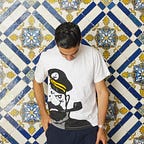5 rules for making almost no money selling t-shirts online
The internet is full of success stories about people making lots of money selling t-shirts online. I’ve been designing and selling t-shirts since 2006. Follow my footsteps to create your own version of the internet’s most rudderless flagship t-shirt brand.
Rule 1: find a niche audience (preferably cut off from the world financial system)
In 2006 I lived in Toronto and I was getting ready to finish grad school. 2006 was also a World Cup year, and Iran –the country I was born in– had made it to the finals for only the second time during my lifetime. I wanted to buy Iran-themed soccer fan shirts, but nobody was selling them. So I jumped on the opportunity to procrastinate –as I often did in grad school– and decided to design and sell my own. And thus began my journey of serial internet t-shirt-preneurship
My target audience were fans of Iranian soccer. Not the tens of millions who lived in Iran — they had no access to credit cards or international online payment platforms thanks to sanctions— but the few hundred thousand soccer fans of Iranian descent in diaspora. Thanks to this narrow pool of potential customers, I never had to worry about things like profit.
Rule 2: don’t protect your designs
There are digital image manipulation techniques you can use when sharing your designs or uploading them online to make it harder for copy cats to steal them. I didn’t use any of them. In fact I liberally uploaded pristine trace-ready images every where to promote my store. One of my early designs –a tribal lion with calligraphic words– became a frequent source of plagiarism. Over the years I’ve seen my lion design tattooed on C-list Iranian celebrities, printed on rival t-shirt sellers’ merchandize, and used as a brand by a “luxury” watch store in NYC.
Rule 3: Keep lots of inventory
After selling a few hundred shirts through an online print-on-demand service, I was ready to take the next step: create a brand, order inventory, and do all fulfillment myself. So I partnered with an old friend to create Xerxes Alliance. I thought I had a brilliant concept: I was going to write a story based on Persian legends and myths, and there would be a shirt for each ‘chapter.’ If you bought the shirt, you got the chapter, and vice versa. I even made a fancy ‘page-turning’ website (warning, it’s flash).
The idea was appealing enough to get us on a local TV segment in Toronto. But apparently not everyone was into Persian mythology. The good news was that my partner and I didn’t have to buy birthday gifts for several years.
Rule 4: build it and they will come
In 2014, just ahead of another World Cup I partnered with a different friend and fellow creative to launch a new brand: Iranian Apparel. Having learned my lesson from the Xerxes saga I went back to the print-on-demand model. Again our audience were Iranian soccer fans. Online shopping was much more of a thing in 2014 than it was in 2006, so we were ready for the floodgates to open. There was no flood.
Rule 5: keep doing it
While my friends and x-partners were smart enough to recognize the terrible return on investment and decided to spend their time more wisely, I’m back at it again for the 2018 World Cup. Whether it is the pleasure of seeing a random person wearing one of my t-shirts, the illusion of doing something creative, or simply naive optimism, I’m continuing to build the internet’s smallest t-shirt empire. You can do it too.
